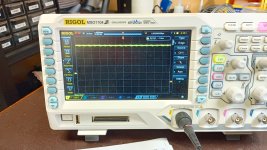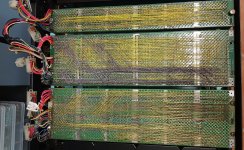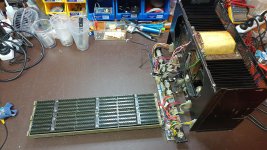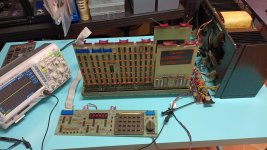Oh no - I am back to square one with my H754.
The H754 was running fine for a while without load, but today morning after about 2 hours of running inside the BA-11K the 20V and -5V rails disappeared. The symptoms were identical to when the +20V and -5V adjustments pots were turned too high.
I have since removed the H754 and have been testing it on the bench and can now reproduce the problem (or something similar???) by simply
disconnecting a previously connected 30 Ohm load resistor between the 20V and -5V outputs while the power is on.
The SCR fires and shorts to ground, actually about 0.7V and the SCR remains triggered. If I reconnect the 30 Ohm load and momentarily short the SCR's cathode and anode the 25V returns.
It appears that the disconnection of the 30 Ohm load causes some instability in the regulations causing some voltage overshoot which in turn is causing the SCR to fire. There is a large 1000 uF cap between GND and 20V and a 2200 uF cap between 20V and -5V which should smooth any brief overshoot.
I hooked up my scope to check the +20V and -5V rails and see the following (please click on the pictures to see the full size image):

Hmmm that is -5V with lots of ripple.

+20V is not much better.
I did my "load disconnect trick" and this is what I see on base of Q12 (which triggers the SCR for -5V overvoltage):

So yes the -5V rail has not just ripples, but as a result of the "load disconnect trick" the rail badly glitches.
But hang on - we have decent size caps to take care of ripple and glitches.
I dug through my electrolytic caps and found a 470 uF 35V which was not really a replacement for the large 2200 uF cap (C9), but I was curious what would happen if I just put it in parallel with C9. The result was pleasing. No more ripple on either 20V or -5V rails and my "load disconnect trick" no longer triggered the SCR.
I then removed the old C9 completely neither ripple nor SCR triggering came back.
Unfortunately I have no way to test the old C9, but it certainly did not contribute to ripple or glitch smoothing. The much smaller 470 uF cap did a sufficient job.
So it seems all along C9 was causing all the headache. Unfortunately it is unlikely that I will find a new exact match screw in replacement, so I will probably just solder in a leaded component.
Here is a photo showing my test setup and the temporary 470 uF replacement cap and the old C9 in front of the PCB:

Tomorrow I will see if I can find a 2200 uF replacement cap locally.
Note to myself: check all the other rails (+15V, -15V, +5V) with the scope for ripple.








